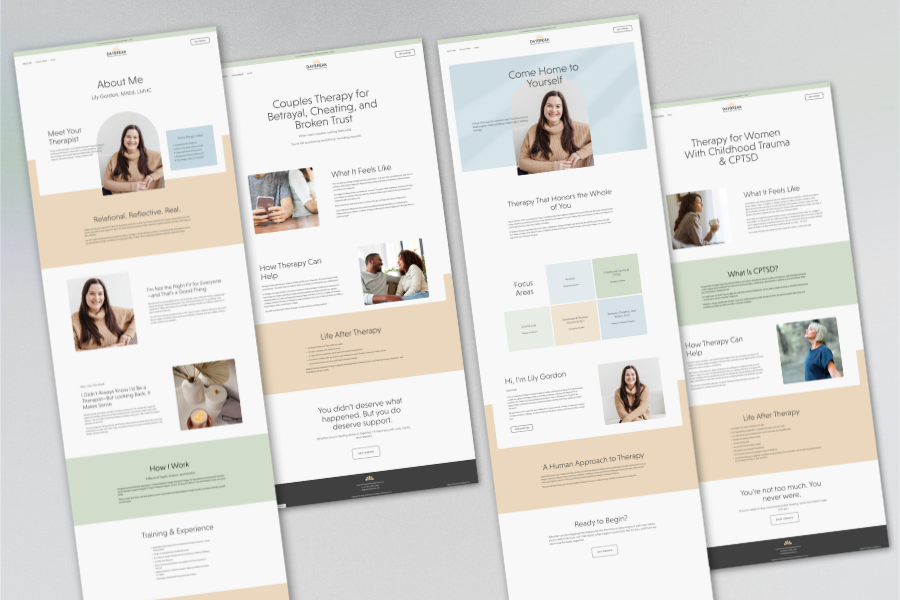How to Stand Out on Psychology Today: Copy Tips That Actually Work
Ever tried finding a therapist using Psychology Today? It’s… a lot.
If you haven’t done it in a while, go try it now. Plug in your location, pick a focus area like “Eating Disorders” or “Drug and Alcohol Abuse,” or select an approach like “Dance/Movement Therapy” or “Ketamine-Assisted Therapy.” Scroll through the results.
How many of the therapists actually mention that specialty in the first few lines of their profile—the text that shows up before you even click?
How many have professional photos that invite trust and warmth at a glance?
As a therapist, you might not realize that two things matter way more than everything else on your Psychology Today profile: your headshot and the first 4–6 lines of your bio. That’s it. That’s the hook.
If those aren’t working hard for you, the rest of your profile may never get seen.
1. The First 4–6 Lines Are Your Ad Space
When someone is browsing therapists in a directory, they don’t click on every profile. They scan photos and skim the 4–6 lines that appear in the search results.
That preview comes from two places: the optional “Preview Text” field (if you’ve filled it out) and the first few lines of your main profile.
This is your best shot at catching someone’s attention.
Don’t use this space to describe your therapeutic orientation (unless your approach is the reason people seek you out, like EMDR or DBT). Instead, speak directly to your ideal client:
What are they dealing with?
What made them start searching today?
What could change for them if they worked with you?
Skip the jargon. Be specific. Make those lines do the heavy lifting.
2. Get a Professional Headshot
It doesn’t need to be expensive. It does need to look like you on a good day, in good lighting, making eye contact with the camera.
You’re not trying to look impressive—you’re trying to look human. Calm. Grounded. Safe.
Compare a blurry webcam selfie with poor lighting to a crisp, friendly headshot in natural light. Which one would you click on?
3. Focus on the Client, Not Your Credentials
Your training and qualifications matter. But they’re not what helps someone feel seen when they’re in a vulnerable place.
Don’t lead with your license type or number of years in practice. Lead with empathy.
Try something like:
“You’ve been holding it together for everyone else, but lately it’s catching up with you.”
That kind of sentence tells a client, “I get you,” and invites them to keep reading.
4. Use Your Niche Like a Beacon
If you work with something specific—especially if it requires extra training, certification, or it’s underrepresented—highlight it immediately.
Say it in the first two lines. Say it in multiple ways so it shows up in search filters.
For example:
“I specialize in therapy for adult children of narcissistic parents.”
“I help creatives struggling with burnout and self-doubt.”
“I offer affirming therapy for trans and nonbinary teens.”
These are the kinds of things people are searching for. Make it easy for them to find you.
5. Cut Anything That Sounds Like Therapist Dinner Party Talk
Let’s be honest: therapists have a habit of writing bios that would sound great at a dinner party with other therapists—but totally miss the mark for clients.
Cut anything that sounds like that last hangout with your grad school friends.
Phrases like:
“Holding space for your healing journey”
“Collaborative, strengths-based approach”
“Authentic therapeutic relationship”
Those might mean a lot to you and your colleagues, but they don’t always land with the people you're trying to help. Say what you actually do and how it helps.
Plain, real, clear.
6. Give Them a Reason to Reach Out
Don’t end your profile with a vague “feel free to reach out.” Try something more specific and encouraging:
“If you’re ready to feel more like yourself again, I’d love to talk.”
“Reach out for a free 15-minute consultation to see if we’re a good fit.”
Sometimes that’s the final nudge someone needs.
Let’s Look at a Real Example
Let’s say Sarah Wilson, LMHC is a telehealth therapist based in Kentucky. She works with adults and teens who struggle with emotional intensity or emotional disconnection—think anger, dissociation, anxiety, and bottling things up. She uses ACT and other mindfulness-based methods to help clients build a better relationship with their emotions.
Here’s how her profile might show up in search results—first the not-so-great version, then a stronger one.
Example 1: Needs Work
Search Results Preview
I use a client-centered and mindfulness-based approach to help individuals navigate their mental health challenges. My goal is to create a safe and supportive environment where healing can take place.
Full Profile Snippet
I am a licensed therapist with experience working with clients dealing with a wide range of issues including anxiety, depression, anger, and trauma. My approach is strengths-based and tailored to the unique needs of each client. I strive to help clients build self-awareness and coping skills through evidence-based practices including ACT and mindfulness. My goal is to hold space for healing, insight, and personal growth.
What’s missing?
No mention of who she helps (e.g., teens or adults who bottle up emotions or feel overwhelmed by them).
Leads with theory and technique instead of results.
Uses broad, vague language that could apply to almost anyone.
Feels like a template bio rather than one with a clear niche.
Example 2: Clear & Compelling
Search Results Preview
If you tend to shut down emotionally or feel like your emotions are “too much,” you’re not alone. I help teens and adults in Kentucky learn how to feel their emotions without letting them take over.
Full Profile Snippet
Maybe you were never taught how to deal with big emotions—so now you bottle them up, explode unexpectedly, or feel totally numb. I work with people who feel overwhelmed by their emotions and are tired of feeling out of control. Whether you shut down, lash out, or simply avoid feelings altogether, therapy can help you build a new relationship with your emotions—one based on compassion, understanding, and real tools. My approach will help you learn how to feel emotions without getting stuck in them. Telehealth sessions available across Kentucky.
What works?
Speaks directly to the client’s lived experience.
Names the emotional patterns people identify with.
Uses plain, empathetic language.
Clear about who she helps, how, and what changes are possible.
Curious which therapist directories to join? Check out this article: How to Choose the Right Online Directories for Your Therapy Practice
Final Thoughts
Your Psychology Today profile doesn’t have to do everything. It just needs to make the right people pause long enough to click.
Use those first few lines to speak directly to your ideal clients. Show them their pain is understood and that help is possible. Pair that message with a clean, approachable photo—and you're already ahead of the game.
Now go take a fresh look at your profile. What’s showing up in those first lines? Would you click on it?
Pin it!
Some of My Favorite Private Practice Tools
Resources and Referral Links




































